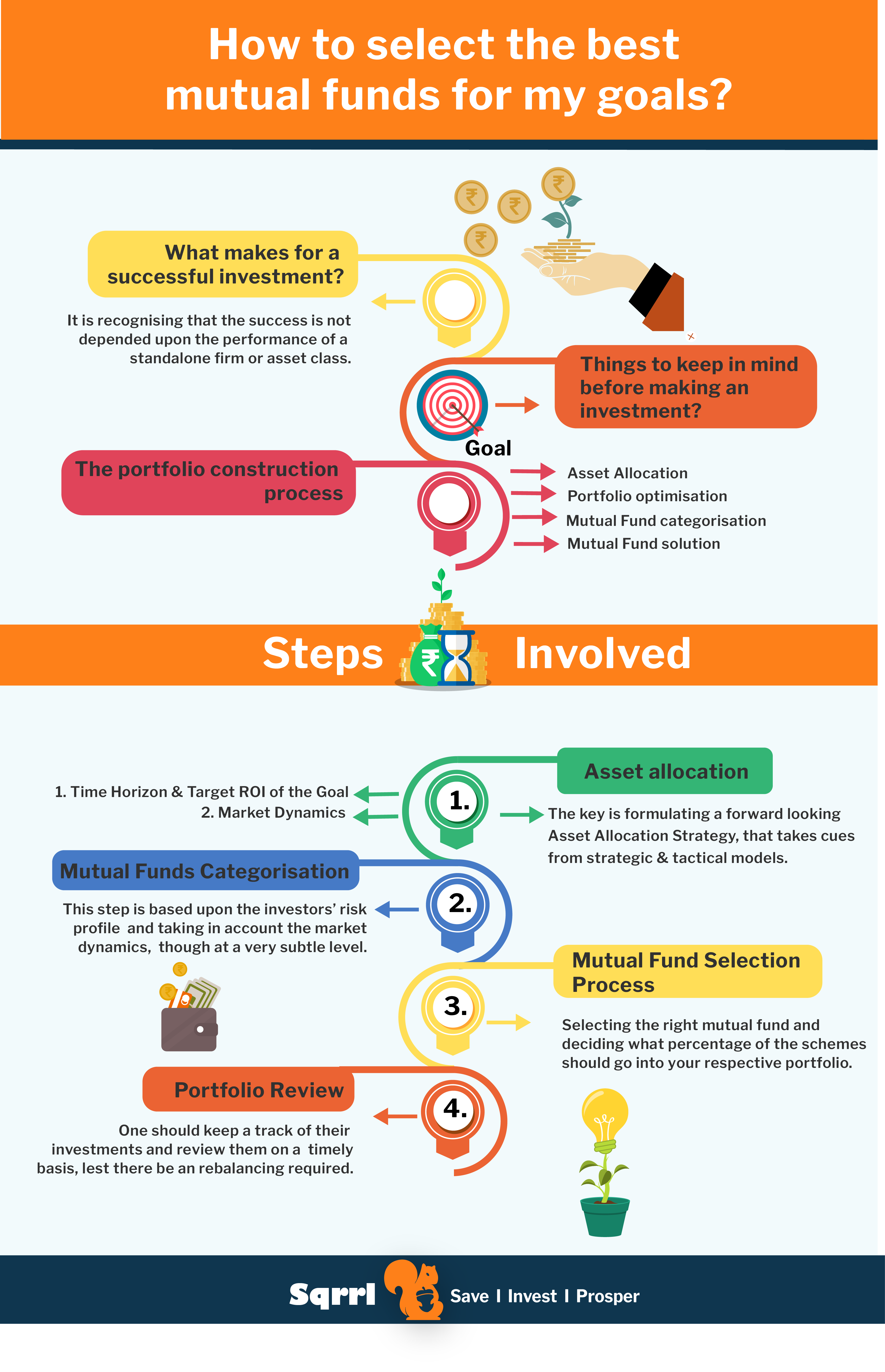How Sqrrl selects the best mutual funds for your goals
BLOG | April 11, 2024


We could have just written this punching phrase in the context of explaining the Investment Process and help you to select Best Mutual Funds to Invest we have carved out for you, given you recommendations, and hope you would accept it. But we agree with you on the fact that hope is just a four letter word and you deserve to know what goes inside to indeed redefine the Advisory Process.
The output of the rigorous process we have put behind would be in the form of Model Portfolios suiting your Risk Profile, Financial Goals & Market Dynamics. The next 5 minutes you spend reading this will change the way you had approached investments, cement your confidence and more importantly make you an informed investor. And of course, you will smile too…

The starting point of an investor-centric approach is simple. It is recognising that success is not depended upon the performance of a standalone firm or asset class. Instead, it is depended upon how well your portfolio ‘dynamically’ interacts with the risk factors impacting your goal, your assets & your future income stream.
Consider this. Visualise yourself walking into a Raymond’s Showroom. You select the best fabric for your dream suit, and let your favourite tailor measure you up. When it does get stitched, you know it is exactly what you wanted it to be.
This is how your investment approach should be, and this is exactly what you would experience at Sqrrl, as far as your investment horizons are concerned.
And ladies, we guarantee that your experience is going to be no less. Just that, our marketing team is yet to figure out an appropriate analogy to describe your excitement. Till then, stay tuned.
Goals
Goals
Goals
Every step that we will outline below is customised exactly to the goal that you are pursuing. Be it your next vacation to Europe, or planning your retirement fund, you can rest assured that Sqrrl’s portfolio construction algorithm will make the perfect fit for you!

Asset Allocation
Mutual Funds Categories
Best Mutual Funds Selection
Portfolio Optimisation

The key is formulating a forward-looking Asset Allocation Strategy, that takes cues from strategic & tactical models.
Therefore, asset allocation will be based on two broad parameters:
1. Time Horizon & Target ROI of the Goal
2. Market Dynamics
The strategic asset allocation will revolve around the first point; while the tactical allocation will be based on the market dynamics. To ascertain the allocation towards the tactical side, we will look at the Valuation & Momentum Metrics of the Equity Markets.
Don’t worry if your head is spinning, let’s take you back to Raymond’s showroom.
You must’ve had some strong preferences when you decided to get that suit made. Maybe in terms of colour, brand, fabric, etc. which you would not have been able to compromise. The salesperson would guide you on the contemporary designs, price brackets, etc. which will help you in refining your selection & get the best pick.
Correlate this to the strategic asset allocation, the core of your investment, which would then be used to craft your investment approach towards risk tolerance. This is what we meant when we talked about Tactical Allocation; adjusting your investments to take advantage of the market movements & price opportunities.
Let’s view this step as a subset of Asset Allocation & as a precedent to the next step of Mutual Fund Selection. This step is based upon the investors’ risk profile and taking in account the market dynamics, though at a very subtle level.
For e.g., Large Cap Funds will occupy the major portion within the Equity exposure for client’s whose risk tolerance is low. As the risk tolerance goes up, Mid Cap & Small Cap Funds would start fitting the bill. For Debt, we will look at the 2 broader themes viz Accrual & Duration, to decide upon the Fund Categorisation into a respective Risk Bucket.

Selecting the right Best Mutual Funds is the most overwhelming task in the entire process. What really separates Sqrrl from the rest of the world id our Research Architectural Framework. It allows us to scan more than 4000 mutual funds schemes and then tailor is down to each individual’s requirements.
The first step in this process is running a quantitative check to rank the schemes from a return & risk perspective:
Our approach is simple, we apply 50% of our decision weight each to Returns & Rations, and then rank these mutual funds on the basis of these.
It begins with applying quantitative parameters such as AUM, Market Cap Up, Fund Manager Vintage, Expense Ratio, Exit Load, Portfolio Yield, Credit Quality & Duration History. And after putting over a 100 schemes into this funnel, we typically end up with 20 – 25 schemes cherry picked for you, matching your financial objectives.

Once we’ve handpicked the Best mutual funds for you; the next obvious step would be to decide what percentage of these schemes should go into your respective portfolio. We use a scientific method here i.e. Mean-Variance Optimisation. This method identifies portfolios that fall on the Efficient Frontier optimising the Risk-return relationship.
Back to the tailor-made suit reference- it’s like telling your tailor to be perfect with the shoulders, seat, jacket length, sleeve, collar, etc.
We take the average return of these schemes for a period of 5 years. Then we calculate the covariance matrix for this same period. We find out the annual variance and return of these portfolios, assuming that the chosen mutual funds were to be distributed evenly in the portfolio.
The next and the most important step is optimising it. We decide what the ideal exposure (%) of these mutual funds should you have in your portfolio. To do that, we focus back on the defined objective for your portfolio. This defined objective might be either to maximise returns or minimise volatility.
For instance, if you’re chasing a goal in the next two years, the objective would then be to minimise volatility as opposed to maximise gains for a goal that has a longer duration.
The portfolio objective would also be based on your Risk Tolerance Scores.

This Flow Diagram helps you to Find out Best Mutual Funds To Invest for Your Goals In Simple Way.

And that’s it. Just how you would go about getting your dream suit tailored, Sqrrl tailors the investments that suit you. And just you!

We’re hoping that by now you’ve got a comprehensive knowledge of how mutual funds work and how they can help you save & grow your money. Let us now introduce you to our app, which is quite frankly India’s simplest mutual funds investment app. We were recently featured by Outlook Money, for our quest to help Indians and especially young Indians save, invest & prosper.
Our app is designed to help all people invest, regardless of whether you have an intricate knowledge of Best Mutual Funds or not. Setting up a SIP, or setting up a future investment like planning a vacation, retirement fund, etc. can be done with Sqrrl in minutes. And don’t you just take our word for it, we’ve got little demos of the app here, go through them and tell us what you think.
You can click here to download our app.